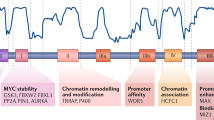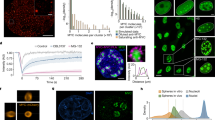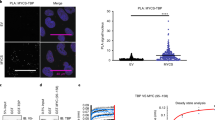Abstract
The proto-oncogene product c-Myc has a direct role in both metazoan cell growth and division1,2,3,4. RNA polymerase III (pol III) is involved in the generation of transfer RNA and 5S ribosomal RNA, and these molecules must be produced in bulk to meet the need for protein synthesis in growing cells5. We demonstrate here that c-Myc binds to TFIIIB, a pol III-specific general transcription factor, and directly activates pol III transcription. Chromatin immunoprecipitation reveals that endogenous c-Myc is present at tRNA and 5S rRNA genes in cultured mammalian cells. These results suggest that activation of pol III may have a role in the ability of c-Myc to stimulate cell growth.
This is a preview of subscription content, access via your institution
Access options
Subscribe to this journal
Receive 51 print issues and online access
$199.00 per year
only $3.90 per issue
Buy this article
- Purchase on Springer Link
- Instant access to full article PDF
Prices may be subject to local taxes which are calculated during checkout





Similar content being viewed by others
References
Dang, C. V. c-Myc target genes involved in cell growth, apoptosis, and metabolism. Mol. Cell Biol. 19, 1–11 (1999)
Elend, M. & Eilers, M. Downstream of Myc—to grow or to cycle? Curr. Biol. 9, R936–R938 (1999)
Schmidt, E. V. The role of c-myc in cellular growth control. Oncogene 18, 2988–2996 (1999)
Grandori, C., Cowley, S. M., James, L. P. & Eisenman, R. N. The Myc/Max/Mad network and the transcriptional control of cell behavior. Annu. Rev. Cell Dev. Biol. 16, 653–699 (2000)
Brown, T. R. P., Scott, P. H., Stein, T., Winter, A. G. & White, R. J. RNA polymerase III transcription: its control by tumour suppressors and its deregulation by transforming agents. Gene Expr. 9, 15–28 (2000)
Rosenwald, I. B. Upregulated expression of the genes encoding translation initiation factors eIF-4E and eIF-2α in transformed cells. Cancer Lett. 102, 113–123 (1996)
Iritani, B. M. & Eisenman, R. N. c-Myc enhances protein synthesis and cell size during B lymphocyte development. Proc. Natl Acad. Sci. USA 96, 13180–13185 (1999)
Johnston, L. A., Prober, D. A., Edgar, B. A., Eisenman, R. N. & Gallant, P. Drosophila myc regulates cellular growth during development. Cell 98, 779–790 (1999)
Schuhmacher, M. et al. Control of cell growth by c-Myc in the absence of cell division. Curr. Biol. 9, 1255–1258 (1999)
Beier, R. et al. Induction of cyclin E-cdk2 kinase activity, E2F-dependent transcription and cell growth by Myc are genetically separable events. EMBO J. 19, 5813–5823 (2000)
Kim, S., Li, Q., Dang, C. V. & Lee, L. A. Induction of ribosomal genes and hepatocyte hypertrophy by adenovirus-mediated expression of c-Myc in vivo. Proc. Natl Acad. Sci. USA 97, 11198–11202 (2000)
Mateyak, M. K., Obaya, A. J., Adachi, S. & Sedivy, J. M. Phenotypes of c-Myc-deficient rat fibroblasts isolated by targeted homologous recombination. Cell Growth Differ. 8, 1039–1048 (1997)
Coller, H. A. et al. Expression analysis with oligonucleotide microarrays reveals that MYC regulates genes involved in growth, cell cycle, signaling, and adhesion. Proc. Natl Acad. Sci. USA 97, 3260–3265 (2000)
Boon, K. et al. N-myc enhances the expression of a large set of genes functioning in ribosome biogenesis and protein synthesis. EMBO J. 20, 1383–1393 (2001)
Hirst, S. K. & Grandori, C. Differential activity of conditional MYC and its variant MYC-S in human mortal fibroblasts. Oncogene 19, 5189–5197 (2000)
Winter, A. G. et al. RNA polymerase III transcription factor TFIIIC2 is overexpressed in ovarian tumors. Proc. Natl Acad. Sci. USA 97, 12619–12624 (2000)
Greasley, P. J., Bonnard, C. & Amati, B. Myc induces the nucleolin and BN51 genes: possible implications in ribosome biogenesis. Nucleic Acids Res. 28, 446–453 (2000)
Steiner, P. et al. Identification of a Myc-dependent step during the formation of active G1 cyclin-cdk complexes. EMBO J. 14, 4814–4826 (1995)
White, R. J., Trouche, D., Martin, K., Jackson, S. P. & Kouzarides, T. Repression of RNA polymerase III transcription by the retinoblastoma protein. Nature 382, 88–90 (1996)
Scott, P. H. et al. Regulation of RNA polymerase III transcription during cell cycle entry. J. Biol. Chem. 276, 1005–1014 (2001)
Sutcliffe, J. E. et al. RNA polymerase III transcription factor IIIB is a target for repression by pocket proteins p107 and p130. Mol. Cell. Biol. 19, 4255–4261 (1999)
Gu, W., Bhatia, K., Magrath, I. T., Dang, C. V. & Dalla-Favera, R. Binding and suppression of the Myc transcriptional activation domain by p107. Science 264, 251–254 (1994)
Hoang, A. T. et al. A link between increased transforming activity of lymphoma-derived MYC mutant alleles, their defective regulation by p107, and altered phosphorylation of the c-Myc transactivation domain. Mol. Cell. Biol. 15, 4031–4042 (1995)
Eilers, M., Schirm, S. & Bishop, J. M. The MYC protein activates transcription of the α-prothymosin gene. EMBO J. 10, 133–141 (1991)
Geiduschek, E. P. & Kassavetis, G. A. The RNA polymerase III transcription apparatus. J. Mol. Biol. 310, 1–26 (2001)
Hateboer, G. et al. TATA-binding protein and the retinoblastoma gene product bind to overlapping epitopes on c-Myc and adenovirus E1A protein. Proc. Natl Acad. Sci. USA 90, 8489–8493 (1993)
Cole, M. D. & McMahon, S. B. The Myc oncoprotein: a critical evaluation of transactivation and target gene regulation. Oncogene 18, 2916–2924 (1999)
Eisenman, R. N. Deconstructing Myc. Genes Dev. 15, 2023–2030 (2001)
Schübeler, D. et al. Nuclear localization and histone acetylation: a pathway for chromatin opening and transcriptional activation of the human β-globin locus. Genes Dev. 14, 940–950 (2000)
White, R. J., Gottlieb, T. M., Downes, C. S. & Jackson, S. P. Mitotic regulation of a TATA-binding-protein-containing complex. Mol. Cell. Biol. 15, 1983–1992 (1995)
Acknowledgements
We thank C. Ngouenet and Z. Felton-Edkins for technical assistance, and R. Reeder, S. Cowley and C. Yost for critique of this manuscript. This work was funded by grants from CONACYT-Mexico (N.G.), the National Institutes of Health/National Cancer Institute (C.G. and R.N.E.), and from Cancer Research UK (R.J.W.).
Author information
Authors and Affiliations
Corresponding authors
Ethics declarations
Competing interests
The authors declare that they have no competing financial interests.
Rights and permissions
About this article
Cite this article
Gomez-Roman, N., Grandori, C., Eisenman, R. et al. Direct activation of RNA polymerase III transcription by c-Myc. Nature 421, 290–294 (2003). https://doi.org/10.1038/nature01327
Received:
Accepted:
Issue Date:
DOI: https://doi.org/10.1038/nature01327
This article is cited by
-
Ribosome biogenesis in disease: new players and therapeutic targets
Signal Transduction and Targeted Therapy (2023)
-
tRNA dysregulation and disease
Nature Reviews Genetics (2022)
-
MYC sensitises cells to apoptosis by driving energetic demand
Nature Communications (2022)
-
Prognostic role of METTL1 in glioma
Cancer Cell International (2021)
-
The genomic loci of specific human tRNA genes exhibit ageing-related DNA hypermethylation
Nature Communications (2021)
Comments
By submitting a comment you agree to abide by our Terms and Community Guidelines. If you find something abusive or that does not comply with our terms or guidelines please flag it as inappropriate.



